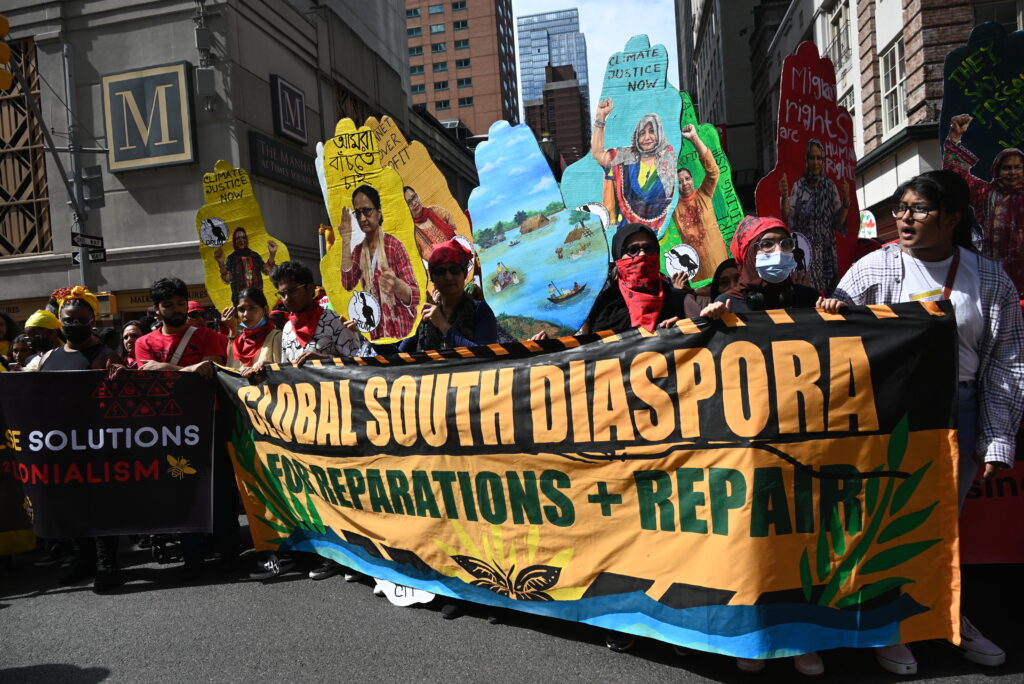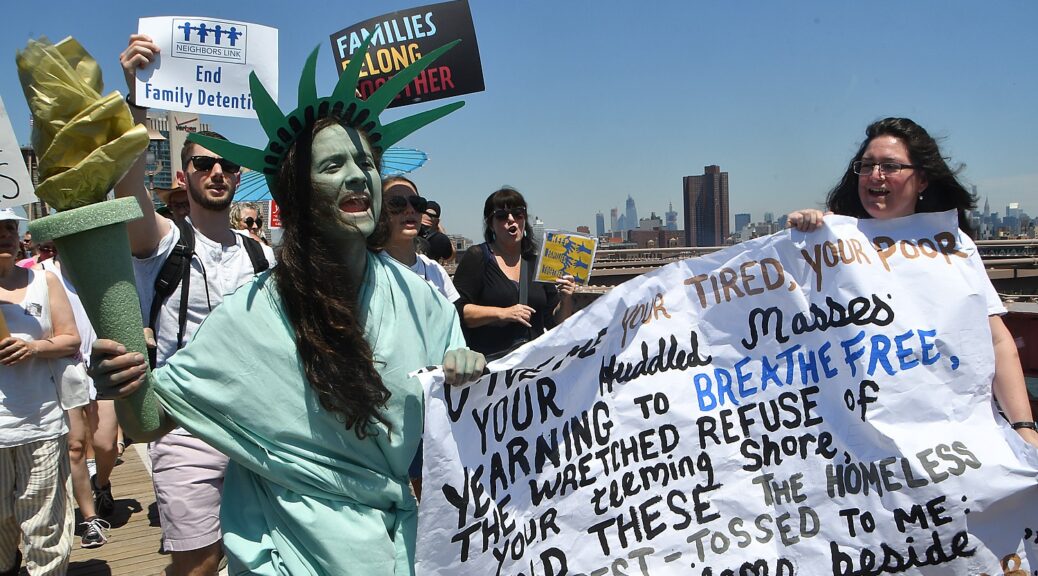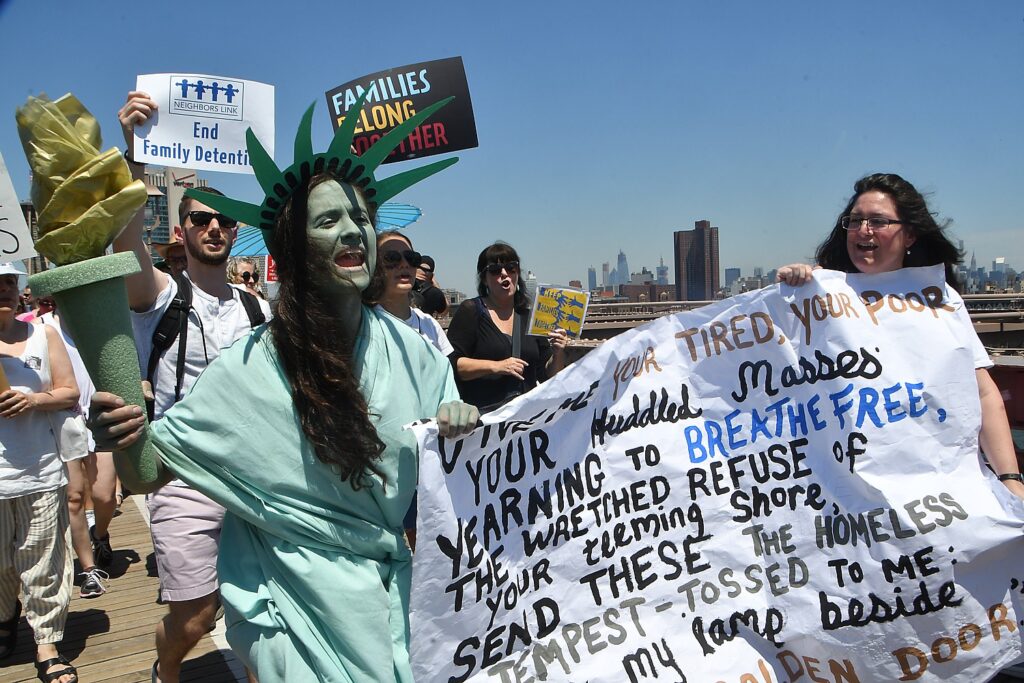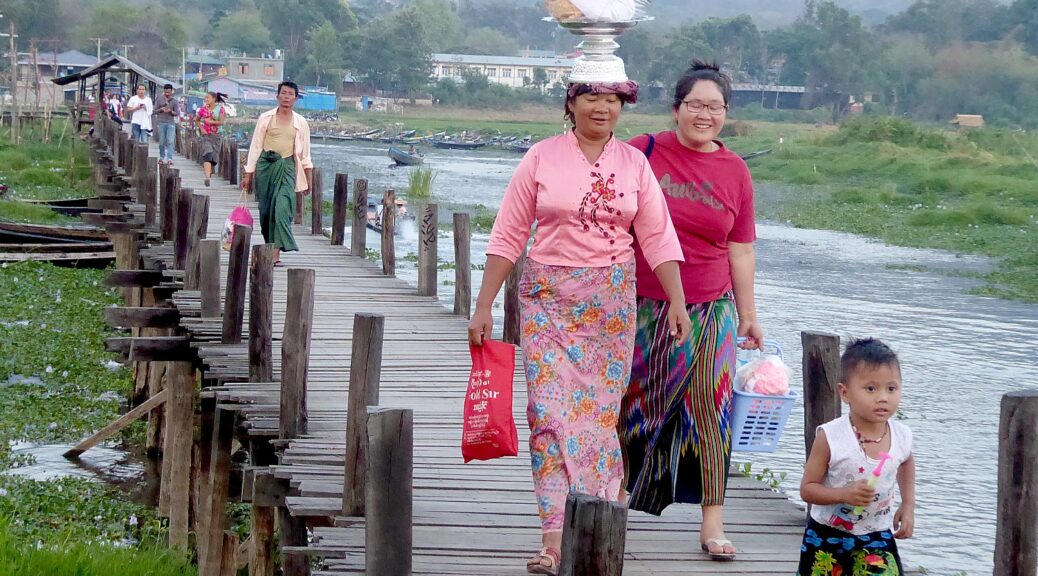
Two years ago, the Biden-Harris Administration released the Report on the Impact of Climate Change on Migration. This update in the report comes at a key time when Republicans in the House and Senate are holding up government funding for border security, foreign aid to Israel, Ukraine and Taiwan, and threatening to shut down the government over inhumane, likely illegal demands to close down migration, when the Biden Administration has attempted to focus on one of the major causes for migration: climate change. This fact sheet was provided by the White House: – Karen Rubin/news-photos-features.com
The Administration provided an update on actions taken under President Biden’s Executive Order 14013 Rebuilding and Enhancing Programs to Resettle Refugees and Planning for the Impact of Climate Change on Migration and efforts to address the effects of climate change on displacement and migration.
Research estimates more than 216 million people could migrate within their countries as a result of climate change by 2050. Migration can be a necessary mechanism for survival for communities and families facing severe risk to personal safety, property damage, or loss of livelihood and is often the only option to meaningfully reduce that risk. Particular attention must be paid to the needs of communities that receive migrants displaced as a result of climate events, including access to housing, work, and education.
Under President Biden’s leadership, the United States Federal government is working to implement a number of initiatives to improve the ability of vulnerable communities both at home and abroad to adapt to and manage the increasing impacts of the global climate crisis that contribute to displacement:
- The President’s Emergency Plan for Adaptation and Resilience (PREPARE), launched by President Biden in November 2021 with a commitment to work with Congress to fund international climate adaptation at $3 billion annually by 2024, has an Action Plan that builds off and bolsters existing international efforts to advance climate resilience, including ways to address key drivers of migration by enabling communities to support themselves where they are, respond to displacement, support those who choose to move as a risk management strategy, and assist trapped populations.
- The U.S. Agency for International Development’s April 2022 Climate Strategy highlights the importance of limiting displacement and supporting safer and more productive migration. This includes the need to anticipate, prepare for, and respond to climate-related migration and scale support to migrants and their communities.
- Lack of access to and availability of water accounted for ten percent of the increase in global migration between 1970 and 2000. The June 2022 White House Action Plan on Global Water Security lays out a whole-of-government approach to improve global resilience, elevate data-driven methods, use resources more efficiently, and work collaboratively across communities and sectors to address global water security, which can be a key driver of displacement and migration due to impacts on health, food security, and livelihoods.
- The Department of State released a new approach in June 2023 to address the impacts of the climate crisis on migration and displacement, including four objectives: 1) strengthen and expand the protection of refugees and migrants in situations of vulnerability affected by climate change; 2) enhance existing climate action by partnering with key humanitarian partners, through regular dialogue with international, governmental, and non-governmental organizations, and through engagement with members of affected populations; 3) expand U.S. multilateral diplomacy and leadership to address the impacts of climate change on migration and displacement in international fora; and 4) strengthen coordination between agencies to advance policy solutions for refugees and migrants affected by climate change.
Additionally, the White House report called for U.S. leadership to elevate the impact of climate change on migration and displacement in multilateral spaces and educate leaders on the urgency of climate risk to populations. The Department of State has advanced dialogue on the issue in various fora over the last two years, including hosting events during the International Dialogue on Migration, Inter-Governmental Consultations on Migration, Asylum, and Refugees, the Organization for Economic Cooperation and Development, UN General Assembly High-Level Week, the Cities Summit of the Americas, the Regional Conference on Migration, and the Africa Climate Summit.
These efforts have generated engagement and momentum among key stakeholders – government, international organizations, impacted communities, multilateral development banks and international finance institutions, civil society, think tanks, the private sector, and others – around action at the intersection of climate change and human mobility. The State Department and USAID will continue working with these stakeholders to inform, develop, and coordinate actions in the years to come.
To address migration and displacement due to climate change, the United States has developed a three-pronged approach of 1) improving access to information by U.S. federal agencies, partner countries, and local communities, 2) increasing investment in adaptation and resilience programs, and 3) facilitating protection of individuals at home and abroad.
Increasing access to information by U.S. federal agencies, partner countries, and local communities on climate change
Information about climate change impacts, early warning systems, and adaptation options saves lives and empowers governments and communities to take timely and appropriate actions to increase climate resilience and address climate-related mobility. The U.S. Government advances observations, models, and forecasts that enable monitoring and early warnings for floods, droughts, cyclones, and extreme temperatures, as well as food insecurity, conflict, and humanitarian needs, including through the following programs:
- The United States Agency for International Development (USAID) established the Famine Early Warning Systems Network (FEWS NET) in collaboration with the United States Geological Survey (USGS), National Aeronautics and Space Administration (NASA), National Oceanic and Atmospheric Administration (NOAA), and the United States Department of Agriculture (USDA) in 1985 in response to devastating famines in East and West Africa to fulfill a critical need for better and earlier warning of potential food security crises. Over the past two years, FEWS NET has increased its investments and partnerships in the climate security domain to better understand interactions between the changing climate, food and water security, fragility, and conflict. Improved understanding and forecasting of these dynamics provide increased insight into migration drivers and patterns, creating opportunities to anticipate, prepare for, and respond to the needs of migrating people.
- The National Geospatial-Intelligence Agency (NGA) and the U.S. Civil Applications Committee lead the Thermal Working Group (TWG), a coordinating body for advancing and enabling delivery of data, information, and products to civil first responders. Since 2021, the TWG has supported wildland fire detection. Increasing average temperatures and related climate change are correlated with observed increases in the occurrence and area burned by fires and the duration of wildfire seasons, increasing the risks associated with disaster-induced displacement. Through continued efforts to improve system processes, the TWG National Guard FireGuard teams have detected and delivered information on more fires (over 2,800 fires total), more quickly, and with greater confidence, enabling earlier and faster local emergency response.
- The USGS provides science to better understand drivers of migration, such as sea-level rise in the Pacific Islands. USGS personnel facilitate the delivery of geospatial data during disaster events, such as the 2022 volcanic eruption in Tonga and 2023 flooding in South Africa, in support of the International Charter: Space and Major Disasters, a United Nations-brokered agreement to provide disaster-related geospatial data and imagery to first responders. Through the USGS-chaired, interagency Civil Applications Committee and National Civil Applications Center, commercial imagery and sensor data are provided to first responders to proactively prepare and respond to these disasters, mitigating the impacts on critical infrastructure and livelihoods.
- The U.S. Global Change Research Program is co-leading an initiative launched in 2021 on Enhancing Capacity for Climate Risk Assessment and Catalyzing Partnerships to Inform Decisions in Latin America and the Caribbean (LACI). The goal of the LACI partnership is to help countries in the region develop capacity to produce national climate assessments that support decision-making and help communities mitigate and adapt to climate change. In June 2023, LACI pilot programs were announced for El Salvador, Amazonia, and Jamaica. This effort directly responds to Executive Order 14008, Tackling the Climate Crisis at Home and Abroad, as well as PREPARE.
- USAID provides life- and livelihood-saving early warning systems and climate information services that help communities, pastoralists, farmers, and local governments better prepare for and adapt to frequent and extreme climate events. USAID partners with leading science organizations to ensure partner governments, civil society, and other stakeholders have context-specific, accurate, and actionable climate information. USAID also invests in capacity building and provides resources for governments and communities to respond and adapt to climate risks. For example, the flagship USAID-NASA partnership, SERVIR, harnesses the power of satellite data to strengthen climate resilience, food and water security, forest and carbon management, and air quality. SERVIR has co-developed over 65 services used around the world to increase early warning lead times for floods, droughts, and high-impact weather events.
- In 2022, USAID made an initial investment of $67 million in partnership with NOAA, the World Meteorological Organization, and the UN Office of Disaster Risk Reduction to advance early warning capacity of national authorities. Through these investments, Flash Flood Guidance System coverage expanded from 74 countries to an additional 20 countries. In addition, USAID will expand the early warning of river and urban flooding droughts, and heatwaves as needed, focusing on small Island Developing States, Africa, and Least Developed Countries. Increasing local capacity for early warning supports governments and communities to better prepare for, plan for, and reduce impact of disaster displacement.
- As announced at the Cities Summit of the Americas in April 2023, more than $1 million in support for USAID’s Roadmaps for Urban Adaptation in Latin America and the Caribbean will provide key information to support urban adaptation and climate resilience, with a focus on those most vulnerable to climate impacts, including migrants and displaced people.
- USAID’s Climate Change, Food Security, and Migration research in Honduras advances understanding of how climate change relates to migration in the country. The research has for instance, revealed a statistically significant relationship between food insecurity and migration; showed that municipal drought has a long-term and cumulative impact on the U.S. border apprehension rate; and demonstrated that coffee prices, which are increasingly affected by climate change, drive migration most where coffee is more important to the local economy. USAID uses this research to help farmers in areas of high migration like Honduras cope with climate impacts. Supporting water-conservating agricultural methods reduces production risks related to drought and enables farming households across Central America to improve soil moisture and fertility, increasing yields by as much as 50 percent.
- With almost $3 million in funding starting in October 2021, USAID has been supporting the Academic Alliance for Anticipatory Action, an innovative partnership between a U.S. university and six universities in Africa and Asia to build the evidence base on why acting ahead of hazards and risks saves lives. Research topics range from assessing the impact of social protection systems on different demographic groups in response to effects of drought in Namibia, to studying the lead time required for different nutrition and health interventions in Eastern Uganda, to examining the use of a flood forecasting system which indicates possible flooding in the Philippines.
Increasing investment in adaptation and resilience programs
Climate variability and change are increasingly contributing to human migration and displacement. Weather-related disasters currently displace around 30 million people annually, even under current warming projections, additional people will be displaced or unable to escape climate impacts. Adaptation and resilience actions can help respond to the key drivers of migration, support those who choose to move as a risk-management strategy, and assist populations trapped by climate impacts. U.S. Government adaptation and resilience initiatives support and scale actions to build the climate resilience of people, places, ecosystems, and livelihoods, including through the following programs:
- A $135 million investment through the Bipartisan Infrastructure Law and Inflation Reduction Act charged the Department of Interior (DOI), the Federal Emergency Management Administration (FEMA), and the Denali Commission to support 11 severely impacted Tribes to advance relocation, managed retreat, and adaptation planning. To date, efforts have focused on outreach to the 11 Tribes, providing technical assistance to build Tribal capacity to adapt, and establishing PL-638 Tribal accounts for initial fund distribution to facilitate the hiring of Tribal relocation coordinators.
- A $40 million investment from the Department of Agriculture funded community-driven relocation projects in 15 Alaskan Tribal communities, with $7 million for seven Emergency Watershed Protection projects in Alaska to relocate homes threatened by erosion, stabilize eroding riverbanks, and restore channel capacity to mitigate flooding.
- USAID’s Climate Strategy sets the ambitious goal of improving the climate resilience of 500 million people by 2030. USAID partners with more than 45 countries to strengthen the resilience of people and communities to address climate impacts across multiple sectors, including issues that are linked to migration and displacement. USAID supports programming to address climate-related migration including:
- In FY21, USAID’s Development Innovation Ventures (DIV) supported Planning for Productive Migration in Niger with a $200,000 pilot evaluation that provided comprehensive job search support and facilitated safe, productive, regional migration as a livelihood strategy for people facing climate change and other challenges within the Economic Community of West African States (ECOWAS).
- In FY22, USAID Burkina Faso’s YouthConnect activity, which improves the resilience and economic empowerment of vulnerable youth, expanded by $4 million to support an influx of persons displaced by climate and conflict;
- In FY22, the $15 million USAID Asia Resilient Cities activity addressed cross-cutting urban development challenges in secondary cities in Asia, with a focus on migrants and informal settlement dwellers, by promoting sustainable urban growth; supporting resilient, low-carbon urban infrastructure; and integrating climate change and environmentally conscious urban development approaches;
- In 2023, USAID partnered with the University of Arizona and universities in Africa, Latin America and the Caribbean, and the Pacific to develop locally led solutions to climate-related disasters by supporting youth and young professionals through an initial grant of $6 million. The program addresses local climate-related challenges in partnership with communities, local governments, NGOs, and the private sector to enable climate adaptation; and
- USAID contributed approximately $1 million in FY22 to the U.N. International Organization for Migration (IOM) for solar water pumping schemes in emergency settings. The USAID-funded Solar Hub provides technical support and training to ensure solar water pumping schemes reach vulnerable populations experiencing climate-related shocks and stressors. Solar water pumps played a critical role during the 2022-2023 Horn of Africa drought, where reduced displacement related to water scarcity by providing safe and cost-effective water access.
- The Department of State’s Bureau of Population, Refugees, and Migration contributed $5 million in FY22 to the UN Migration Multi-Partner Trust fund. This funding supports labor mobility and climate resilience in the Pacific, facilitates safe and regular migration in the Eastern Africa; enhances climate resilience for migrant and vulnerable households in coastal India; and strengthens capacities in the Brazilian Amazon to face the challenges of migration, climate change, and health. This funding addressed needs and gaps in: 1) data and knowledge, 2) national and regional policy frameworks, 3) disaster displacement preparedness, and 4) regular migration pathways.
Protecting people at home and abroad from climate change
Climate change has disproportionate impacts on vulnerable groups, including marginalized communities and people already displaced. Climate-induced displacement creates additional vulnerabilities, which the United States aims to mitigate through programs to address the needs of those displaced by climate change, inclusion of displaced persons in climate action plans and programs, and support community-driven relocation plans, such as the following:
- Department of State’s Bureau of Population, Refugees, and Migration’s contributions to the UN Refugee Agency (UNHCR), International Committee of the Red Cross (ICRC), the International Organization of Migration (IOM), and other humanitarian agencies support climate adaptation and mitigation for refugees, internally displaced persons, conflict victims, migrants, stateless persons, and their host communities in climate-vulnerable countries. For example, with Department of State support:
- UNHCR helps Rohingya refugees in southern Bangladesh mitigate the effects of monsoon storms, flooding, and landslides;
- IOM conducted capacity-building efforts in Central America to assist national and local authorities in better understanding the impact of climate change on migration flows, and their implications in terms of human rights, protection, and development;
- IOM supports government authorities in Angola, Djibouti, Libya, Mozambique, Tanzania, Zambia, and other countries in including migrants in their disaster preparedness and response plans;
- IOM prevents and mitigates human trafficking in Kenya brought on by vulnerabilities and displacement exacerbated by climate change. IOM is raising awareness of risks and employing a variety of livelihood support models to build economic resilience in communities facing economic insecurity due to climate change; and
- At the August 2023 Africa Climate Summit in Nairobi, Kenya, U.S. Special Presidential Envoy for Climate John Kerry announced the Department of State’s contribution of $4 million to the IOM to enhance data collection on climate change and human mobility, and to support migrants, refugees, and host communities impacted by climate events in Kenya.
- USAID delivers assistance to the most vulnerable communities and addresses migration and displacement linked to climate change impacts. This assistance comes prior to, during, and after a humanitarian crisis. USAID responds on average to 75 crises in nearly 70 countries each year. USAID also works to address the long-term needs of displaced persons, including those impacted by climate change. For example, in FY22, USAID/Somalia invested $11 million in Building Durable Solutions to Displacement to support the resilience of long-term internally displaced people (IDPs) affected by climate- and conflict-related disasters. By facilitating access to land titles, formal rental agreements, and improved livelihood prospects, USAID is forging avenues for these families to integrate productively and safely into urban economies, transforming their displacement into opportunities for development.
- In August 2023, the Department of State supported a technical conference that resulted in the continent-wide expansion of the Kampala Declaration on Migration, Environment, and Climate Change, in partnership with IOM and the United Nations Framework Convention on Climate Change’s (UNFCCC) Regional Collaboration Center for East and Southern Africa. The Declaration is a potential example for other regional blocs to collaborate on the challenges posed by the intersection of climate change and migration.
- The Department of State’s Office to Monitor and Combat Trafficking in Persons is supporting programs to conduct research on and address human trafficking in climate-induced migration, including:
- IOM, with Columbia University, is conducting research on human trafficking in cross-border migration linked to climate change and its impact on livelihoods and food security in places including Angola, Namibia, South Africa, Zimbabwe, Lesotho, and South Africa;
- In Bangladesh, a program aims to integrate anti-trafficking policies into existing government plans to address climate change, while building the capacity of vulnerable communities. The program is also conducting research to better understand the link between climate change and human trafficking.
- Johns Hopkins Bloomberg School of Public Health has incorporated research on the climate change-human trafficking nexus within the brick-kiln industry in Pakistan as a result of the 2022 “super flooding,” which displaced hundreds of thousands of the country’s most vulnerable workers. The findings were used to refine the interventions on human trafficking in the brick-kiln industry.
- The Department of Homeland Security’s (DHS) U.S. Citizenship and Immigration Services (USCIS), in furtherance of Section 6 of Executive Order 14013, updated its combined asylum officer and refugee officer training materials in July 2023 to provide guidance on the intersection of climate change and asylum and refugee claims under existing law. USCIS basic training for all new asylum officers and refugee officers includes specific training and activities related to the intersection of climate change and protection claims.
- DHS, through USCIS, issued new, first-of-its-kind guidance in August 2023 to assist stateless noncitizens in the United States who wish to obtain immigration benefits or have submitted other requests to USCIS. Stateless individuals are those who are not legally considered a citizen of any country, and therefore may be denied legal identity, and struggle to access education, healthcare, marriage, and job opportunities. Individuals can be born stateless or become stateless because of discrimination, war and conflict, or changing borders and laws, including due to the potential impacts of climate change.
- DHS has also used its authority to designate certain countries for Temporary Protected Status (TPS), issuing 12 new designations and redesignations under the Biden-Harris Administration. There are 16 TPS designations in place currently. TPS can be issued to protected noncitizens in the United States when their home countries are facing armed conflict, environmental disaster, or other extraordinary and temporary conditions.
- The Department of Housing and Urban Development released a Climate Resilience Implementation Guide for Community Driven Relocation in March 2023, which provides a step-by-step guide for communities seeking to implement a community-driven relocation program.
See also:
FACT SHEET: BIDEN-HARRIS ADMINISTRATION LEVERAGES HISTORIC US CLIMATE LEADERSHIP AT HOME AND ABROAD TO URGE COUNTRIES TO ACCELERATE GLOBAL CLIMATE ACTION AT COP28










